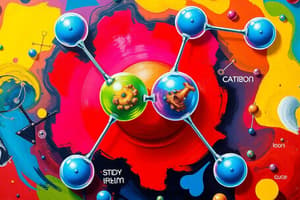Podcast
Questions and Answers
What type of isomerism occurs when a ligand bound to the central atom exchanges places with the counterion?
What type of isomerism occurs when a ligand bound to the central atom exchanges places with the counterion?
- Linkage Isomerism
- Hydrate or Solvate Isomerism
- Coordination Isomerism
- Ionization Isomerism (correct)
What type of isomerism involves the exchange of water or solvent molecules between the coordination compounds?
What type of isomerism involves the exchange of water or solvent molecules between the coordination compounds?
- Coordination Isomerism
- Cis-Trans Isomerism
- Ionization Isomerism
- Hydrate or Solvate Isomerism (correct)
In which type of isomerism do compounds containing complex anionic and complex cationic parts exchange one or more ligands?
In which type of isomerism do compounds containing complex anionic and complex cationic parts exchange one or more ligands?
- Coordination Isomerism (correct)
- Hydrate or Solvate Isomerism
- Cis-Trans Isomerism
- Linkage Isomerism
Which type of isomerism involves the exchange of ligands between two different coordination compounds?
Which type of isomerism involves the exchange of ligands between two different coordination compounds?
When does cis-trans isomerism occur in a coordination compound?
When does cis-trans isomerism occur in a coordination compound?
What defines coordination compounds?
What defines coordination compounds?
What is the main cause of isomerism in coordination compounds?
What is the main cause of isomerism in coordination compounds?
Which type of isomerism results from the different arrangement of ligands themselves?
Which type of isomerism results from the different arrangement of ligands themselves?
In which type of isomerism do molecules have non-superimposable mirror images?
In which type of isomerism do molecules have non-superimposable mirror images?
What differentiates optical isomerism from other types of isomerism in coordination compounds?
What differentiates optical isomerism from other types of isomerism in coordination compounds?
Which type of isomerism leads to compounds with the same chemical composition but different structural formulas?
Which type of isomerism leads to compounds with the same chemical composition but different structural formulas?
Why is understanding various types of isomerism essential for studying coordination compounds?
Why is understanding various types of isomerism essential for studying coordination compounds?
Flashcards are hidden until you start studying
Study Notes
Isomerism in Coordination Compounds
Isomerism in coordination compounds refers to the presence of multiple compounds with the same chemical composition but different structural formulas. Coordination compounds are chemical compounds in which a group of anions is attached to a central metal atom via covalent bonds. There are various types of isomerism in coordination compounds, including:
-
Ionization Isomerism: This occurs when a ligand bound to the central atom exchanges places with the counterion, resulting in different coordination numbers for the central atom.
-
Hydrate or Solvate Isomerism: This type of isomerism involves the exchange of water or solvent molecules between the coordination compounds, leading to different hydrates or solvates.
-
Coordination Isomerism: This isomerism occurs in compounds containing complex anionic and complex cationic parts, where the anion and cation complexes of a coordination compound exchange one or more ligands.
-
Linkage Isomerism: This type of isomerism involves the exchange of ligands between two different coordination compounds, resulting in different linkage isomers.
Cis-Trans Isomerism
Cis-trans isomerism, also known as geometric isomerism, occurs when the arrangement of ligands around the central atom differs in a coordination compound. For example, in the isomeric pair of diamminedichloroplatinum compounds, the two ammonia molecules and the two chlorine atoms are arranged differently.
Ligand Isomerism
Ligand isomerism is another type of isomerism in coordination compounds where the overall isomerism results from the isomerism of the ligands themselves. For example, bis(1,3-diaminopropane)platinum(2+) and bis(1,2-diaminopropane)platinum(2+) are isomeric coordination compounds due to the different arrangement of the ammonia molecules.
Optical Isomerism
Optical isomerism is the phenomenon exhibited by molecules when they have similar chemical compositions but different structural formulas, leading to the presence of non-superimposable mirror images. This type of isomerism is less common in coordination compounds compared to other types of isomerism.
Conclusion
Isomerism in coordination compounds is a complex phenomenon that leads to the existence of multiple compounds with the same chemical composition but different structural formulas. Understanding the various types of isomerism and their subtypes is essential for studying the properties and behavior of coordination compounds in chemistry.
Studying That Suits You
Use AI to generate personalized quizzes and flashcards to suit your learning preferences.




